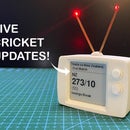Introduction: Voltage Measurement Using Arduino
Measuring voltage is quite easy using any microcontroller as compared to the measurement of current. Measuring voltages becomes necessary if you are working with batteries or you want to make your own adjustable power supply. Though this method applies to any uC but in this tutorial, we will learn how to measure voltage using Arduino.
There are voltage sensors available in the market. But do you really need them? Let's find out!
Step 1: Basics
A microcontroller cannot understand analog voltage directly. That is why we have to use an Analog to Digital Converter or ADC in short. Atmega328 which is the brain of the Arduino Uno has 6 channel (marked as A0 to A5), 10-bit ADC. This means that it will map input voltages from 0 to 5V into integer values from 0 to (2^10-1) i.e. equal to 1023 which gives a resolution of 4.9mV per unit. 0 will correspond to 0V, 1 to 4.9mv, 2 to 9.8mV and so on till 1023.
Step 2: Measuring 0-5V
First, we will see how to measure voltage with a maximum voltage of 5V. This is very easy as no special modifications are required. To simulate the varying voltage, we will use a potentiometer whose middle pin is connected to any one of the 6 channels. We will now write the code to read the values from ADC and convert them back into useful voltage readings.
Reading the analog pin A0
value = analogRead(A0);
Now, the variable 'value' contains a value between 0 to 1023 depending upon the voltage.
voltage = value * 5.0/1023;
The obtained value is now multiplied by the resolution (5/1023 = 4.9mV per unit) to get the actual voltage.
And finally, display the measured voltage on the Serial monitor.
Serial.print("Voltage = ");
Serial.println(voltage);Attachments
Step 3: Measuring Voltage Above 5V
But the problem arises when the voltage to be measured exceeds 5 volts. This can be solved using a voltage divider circuit which consists of 2 resistors connected in series as shown. One end of this series connection is connected to the voltage to be measured (Vm) and the other end to the ground. A voltage (V1) proportional to the measured voltage will appear at the junction of two resistors. This junction can then be connected to the analog pin of the Arduino. The voltage can be found out using this formula.
V1 = Vm * (R2/(R1+R2))
The voltage V1 is then measured by the Arduino.
Step 4: Building the Voltage Divider
Now to build this voltage divider, we first need to find out the values of resistors. Follow these steps to calculate the value of resistors.
- Determine the maximum voltage which is to be measured.
- Decide a suitable and standard value for R1 in kilo-ohm range.
- Using formula, calculate R2.
- If the value of R2 is not (or close to) a standard value, change R1 and repeat the above steps.
- Since Arduino can handle a maximum of 5V, V1 = 5V.
For example, Let the maximum voltage (Vm) to be measured be 12V and R1 = 47 kilo-ohms. Then using the formula R2 comes out to be equal to 33k.
Now, Build a voltage divider circuit using these resistors.
With this setup, we now have an upper and lower limit. For Vm = 12V we get V1 = 5V and for Vm = 0V we get V1 = 0V. That is, for 0 to 12V at Vm, there will be a proportional voltage from 0 to 5V at V1 which can then be fed into the Arduino as before.
Step 5: Reading the Voltage
With a slight modification in the code, we can now measure 0 to 12V.
Analog value is read as before. Then, using the same formula mentioned previously, the voltage between 0 and 12V is measured.
value = analogRead(A0); voltage = value * (5.0/1023) * ((R1 + R2)/R2);
The commonly available Voltage Sensor Modules are nothing but just a voltage divider circuit. These are rated for 0 to 25V with 30 kiloohm and 7.5 kilo-ohm resistors.
So, Why to BUY, when you can DIY!
Thank you for sticking till the end. I hope that this tutorial would have helped you.
Subscribe to my YouTube channel for more upcoming projects and tutorials. Thanks once again!














